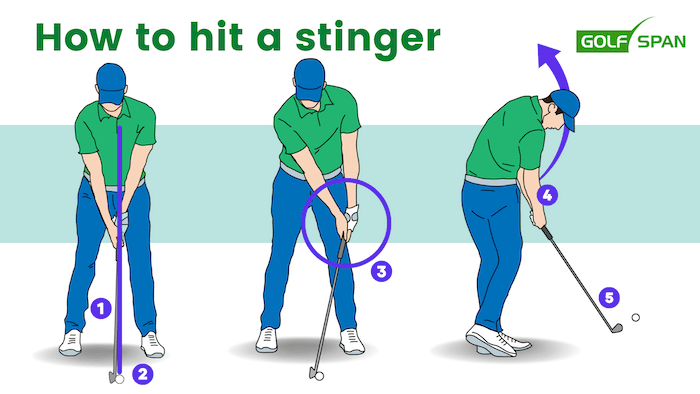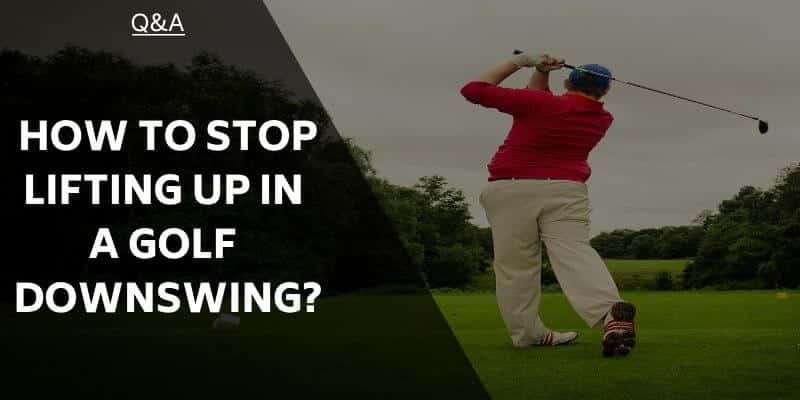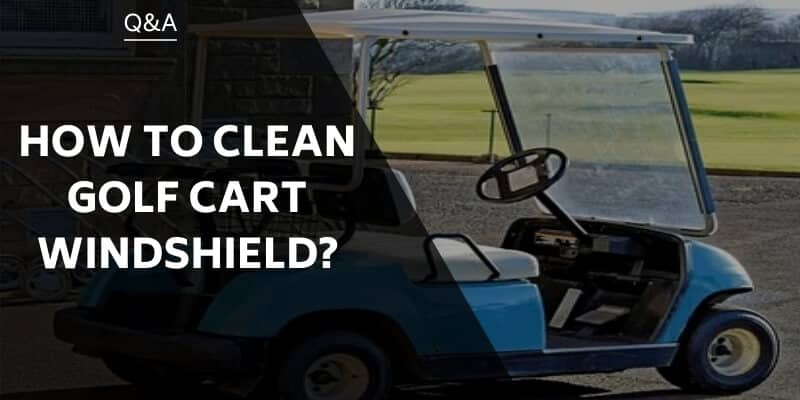Knowing how to hit a low golf shot is important to be able to play in windy conditions. In principle, golf is a simple game where you attempt to get a little round ball into a hole in as few shots as possible. In practice, it is a different kettle of fish. Getting your ball from tee to green requires common sense, accuracy, and luck.
To have the best chance of keeping your scores low, it is best to hold a range of shots in your arsenal to navigate various conditions. In this post, I am teaching you how to hit a low golf shot that can be executed in windy conditions and from behind trees.
When Should You Hit A Low Golf Shot?
A low golf shot, also called a stinger golf shot is a piercing, controlled shot. This shot is flighted down much further than a normal trajectory golf shot. The stinger also has less spin and will roll out considerable distances. It is a useful shot in some situations.
When should you use a stinger?
- When you want to find the fairway on a tight driving hole.
- When you need to keep a shot low but still get some distance out of it.
There is no doubt that Tiger Woods has made the stinger a very popular shot in golf. Tiger first used the shot when he was a young golfer. He is said to have discovered the stinger with a 1 iron he took from his dad.
But this type of low-flighted, punch-type shot has always been part of the game. The stinger is referenced and used almost daily, multiple times, in professional golf.
Read more: The Different Types of Golf Shots
Why Do Golfers Hit the Stinger?
Knowing how to hit a low stinger in golf can help you in some critical situations.
It is used in numerous situations by professional golfers and more skilled amateurs. Middle and higher-handicap golfers seem to hit it less. That is likely because of a lack of understanding on how to hit the stinger.
Here are some more situations that you often see the stinger used.
- On par 4s and 5s with a tight opening off the tee
- On par 4s and 5s with narrow fairway landing areas off the tee
- On par 4s and 5s with narrow approach shots to the green
- In windy weather, especially if it’s blowing into your face
- In situations when you are in trouble and need to keep a shot low to escape
- A long second shot on a par 5 where you need control and could benefit from extra roll
Who Should Hit A Low Golf Shot?
Any golfer can try to hit the stinger. But it is challenging to hit, so professionals and low-handicap amateurs usually use it more. This doesn’t mean, however, that other golfers can’t learn the shot and try to use it.
Better players use the stinger more because they tend to control the clubface better. The ability to have control of the clubface is a key component of the stinger shot.
Many golfers with a middle to high handicap tend to have issues with face control. The dreaded slice also plagues them.
The slice is a result of a swing path on the downswing that is out to in. To be able to hit a stinger, a golfer with this swing path on the downswing will need to learn how to swing from the inside.
With an understanding of how to do it, and with enough practice, anyone can learn how to hit the stinger.
What Does It Take To Hit A Low Golf Shot?
According to PGA golf coach Rick Shiels, there are three core steps needed for you to successfully hit a low golf shot, also known as a punch. These steps require you to position the ball back in your stance, reduce your ball speed, and finish the strike with your hands low.
When you hit a low golf shot, your launch angle should be similar to that of a club with a strengthened loft. These shots are useful in windy conditions or when dense tree canopies sit in your shot path.
How to Hit a Low Golf Shot Consistently Well
A low golf shot is also called a stinger, so I’ll refer to it as that at times.
Besides the three core steps suggested by Shiels, I would also recommend taking a leaf out of golf coach Chris Ryan’s book by positioning your hands in front of the ball at setup. This way, you will know where your clubhead should be at impact to pull this shot off.
I have seen many amateur golfers find it awkward to position their hands in front of the ball. As a result, they adjust their position on their backswing, which compromises the planned shot.
With this in mind, let us analyze the steps you need to take to hit a low golf shot consistently.
Step 1 – Think About Your Shot Path
Before we look at how to set up and hit a stinger, you will need to assess your ball’s lie and your shot options. If you are on the fairway and playing in windy conditions, you likely want to hit the ball low and straight. If that sounds like you, then proceed to step 2.
However, if you play on Parkland courses and end up behind trees, more often than not. It is time that you learn how to hit a low golf shot with shape. You can study the mechanics of these shots in previous posts that I have written. Here are my instructions on how to hit a draw and how to hit a fade.
Step 2 – Select One Club More Than Usual
Hitting a punch shot requires less clubhead and ball speed, meaning that you will not achieve your normal distance with the same club. Therefore you should take more club when hitting a punch to ensure you get the ball to your target.
For example, if you have 160 yards out and you would usually strike a 7-iron, rather takeout a 6. David Leadbetter suggests that you even consider two cubs more. This shot works best with your long to mid-irons as the strengthened loft will help you the ball down.
Step 3 – Grip Down On Your Club
In his tutorial on How to Master the Low Punch Shot, David Leadbetter suggests gripping down on the club by 2-inches. That will help you to gain better control and feel of the club. It further aids you to reduce your ball speed and ensure a low launch angle.
Step 4 – Place The Ball Back in Your Stance
When you hit a driver off of the tee the aim is to hit the ball on your upswing. As a result, you place it in the front of your stance. Conversely, to hit a low golf shot, you need to position the ball towards the back of your stance. It helps you to make contact with the ball when your face is closed. This increases your chance of launching the ball at a lower degree.
Step 5 – Position Your Hands In Front Of The Ball
Once you have your ball positioned to the back of your stance, it is time to address the ball. Before you take a practice swing, place the clubhead behind the ball.
Then position your hands in front of the ball so that your clubface is closed. Finally, take a few practice swings and get used to the feel of hitting the ball in this position.
Step 6 -Place Your Weight Forward
If you are trying to hit the ball on your upswing as you do with a driver off the tee, you may shift your weight slightly back. When it comes to hitting a low golf shot, you need to shift your weight forward.
The reason for this is that it helps you to attack the ball at a steeper angle. That will enable you to connect the ball with a closed clubface, which will keep it low.
Step 7 – Shorten Your Swing To Three Quarters
One of the main components of pulling off a low golf shot is to generate less ball speed. This reduces the launch of the ball and helps you achieve the desired result. Not taking a full swing will assist you in stopping your hands low on your follow-through.
Step 8 – Steep Angle Of Attack
To keep the ball low, you need to attack the ball from a steep angle to ensure that you make contact with it when your face is closed.
If you have a gradual angle of attack, you will swing through like a normal shot enjoying your standard level of loft and defeating the point of steps 1 through 5. A steep angle of attack for amateurs is between -4 to -6 degrees. Golf coach Alistair Davies achieves this will demonstrating a punch shot in this tutorial.
Step 9 – Keep Your Hands Ahead of the Ball
Upon impact, make sure that your hands are ahead of the ball, as you prepared for in step 2. This will keep the face of your club closed and launch the ball at the desired low angle.
Step 10 – Let Your Hands Lead Your Clubhead
If you swung no more than three quarters, you should have taken off sufficient speed to finish with your hands in a lower position than on a full shot. This means that your hands have led the clubhead and been able to finish in a lower position. Ultimately, your hands should come to a halt around your body rather than up and over your shoulders.
Bonus Tip
Practice Your Low Golf Shot on The Range
The most common problem amateur golfers have with the punch shot is that they do not practice it enough on the range. The focus is more on bombing drives and increasing distance. As a result, amateurs usually attempt the shot when they are on the course and stuck behind a tree or playing in gale-force winds.
Final Thoughts
Having a diverse range of shots in your arsenal can only enhance your game. Scrambling is a large part of golf, and if you can get out of trouble successfully, you will be able to keep your scores low.
Furthermore, if you can keep the ball low in the wind, you will be able to navigate most conditions. So, it is advisable to consistently practice this shot on the range to prepare yourself for the worst on the course.
Remember, ball back in your stance, three-quarter swing, and let your hands lead the clubhead. Now that you know how to hit a low golf shot, get out there and start executing.
Related Articles
- Does Rain Affect Golf Ball Distance?
- The Best Golf Training Aids For Game Improvement in 2024
- How to Swing a Golf Club
- David Leadbetter StraightAway Swing Aid
Nick is the founder of GolfSpan and an avid golfer. He's not quite a pro but has over 15 years of experience playing and coaching golfers worldwide. His mission is to bring the golfing community a better experience when it comes to choosing the right golf gear and finding the right setup for your game.







